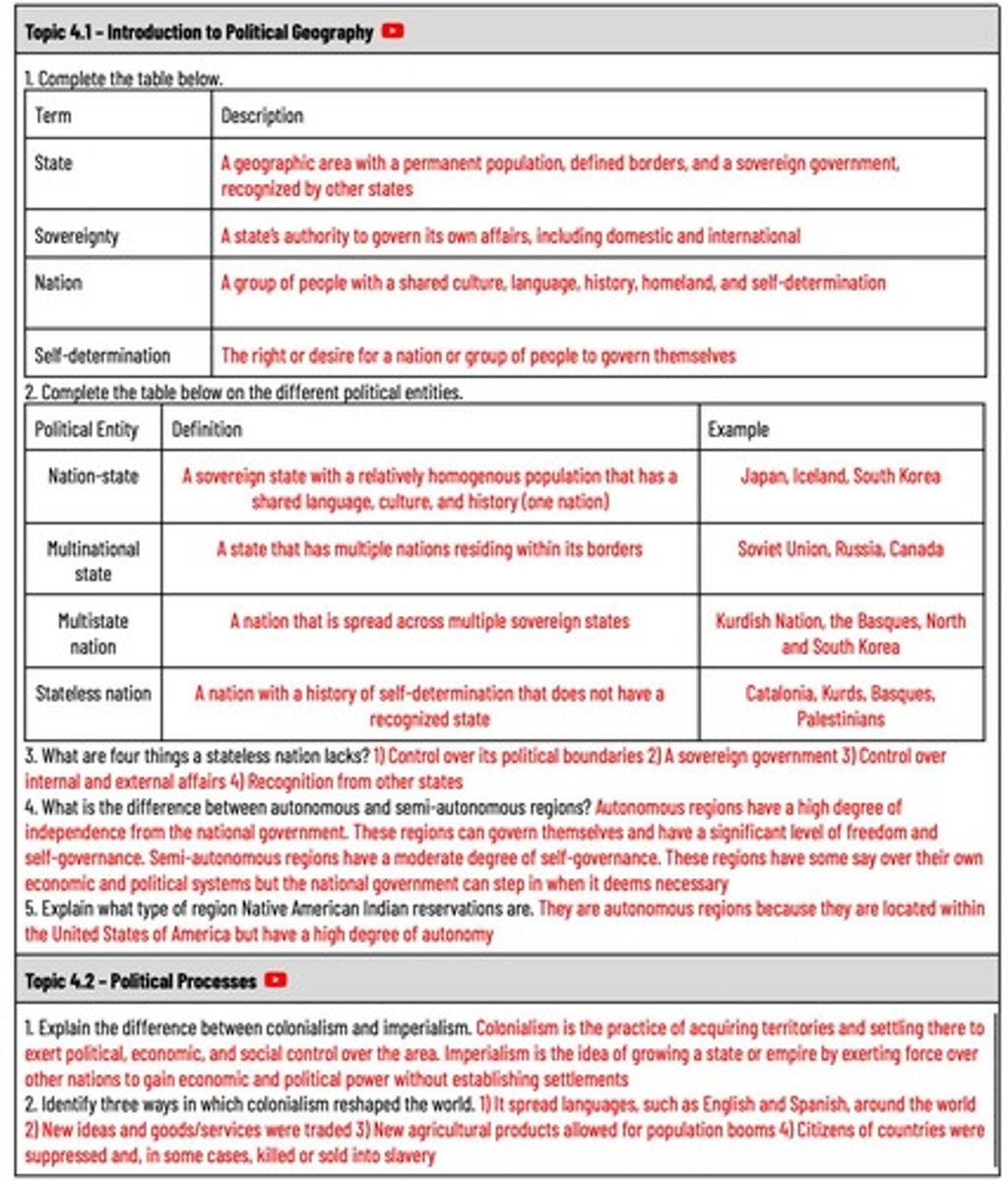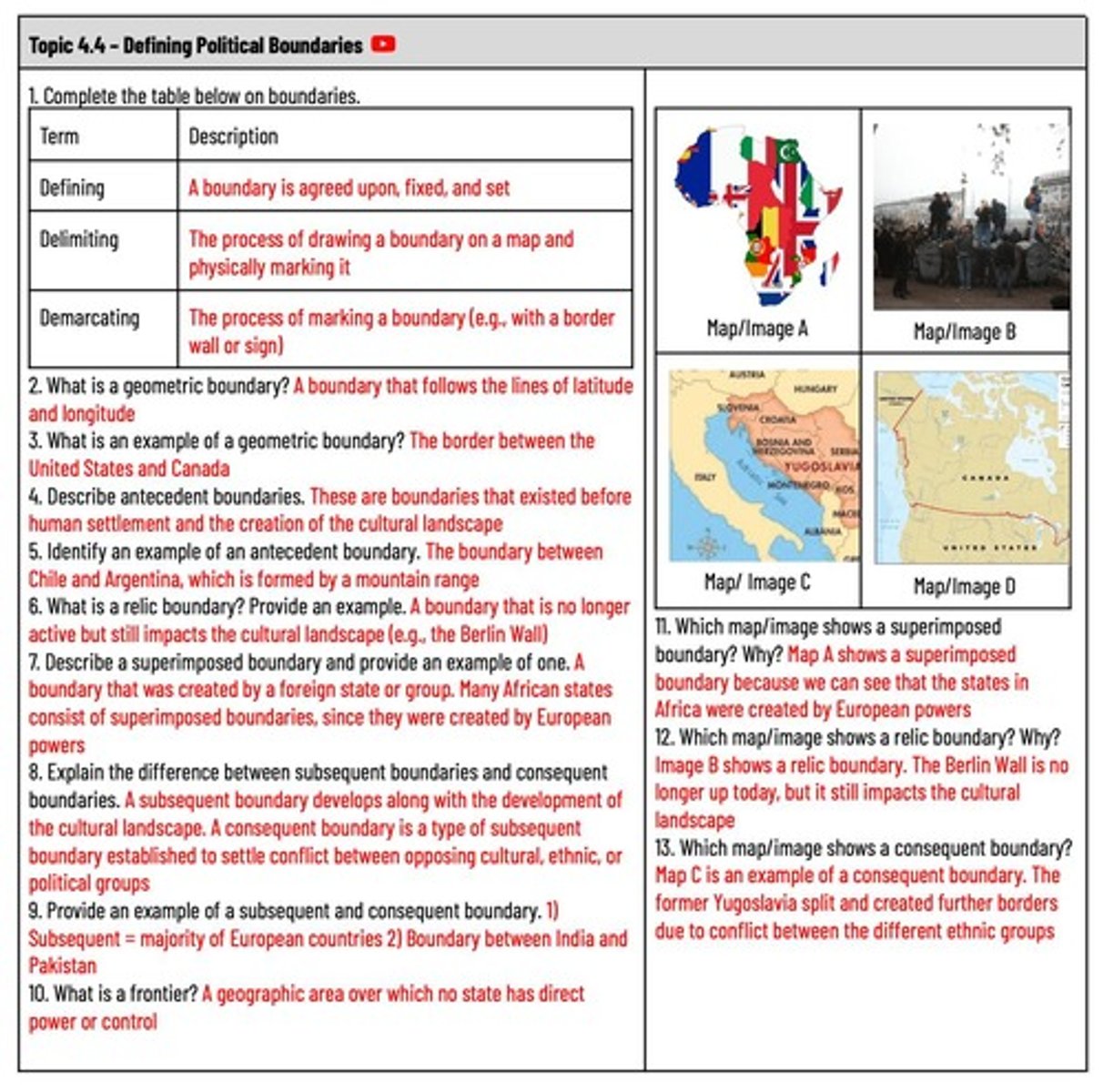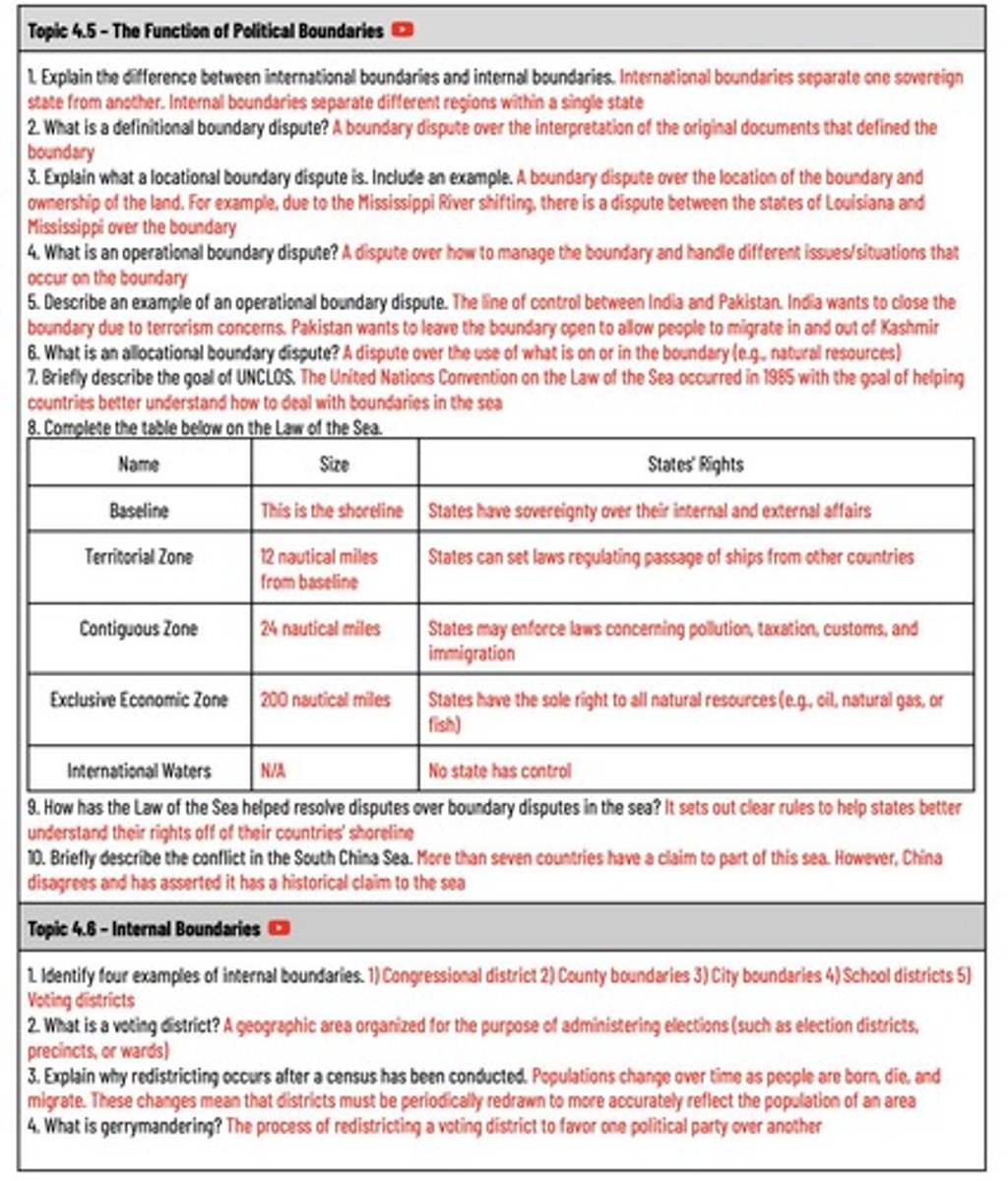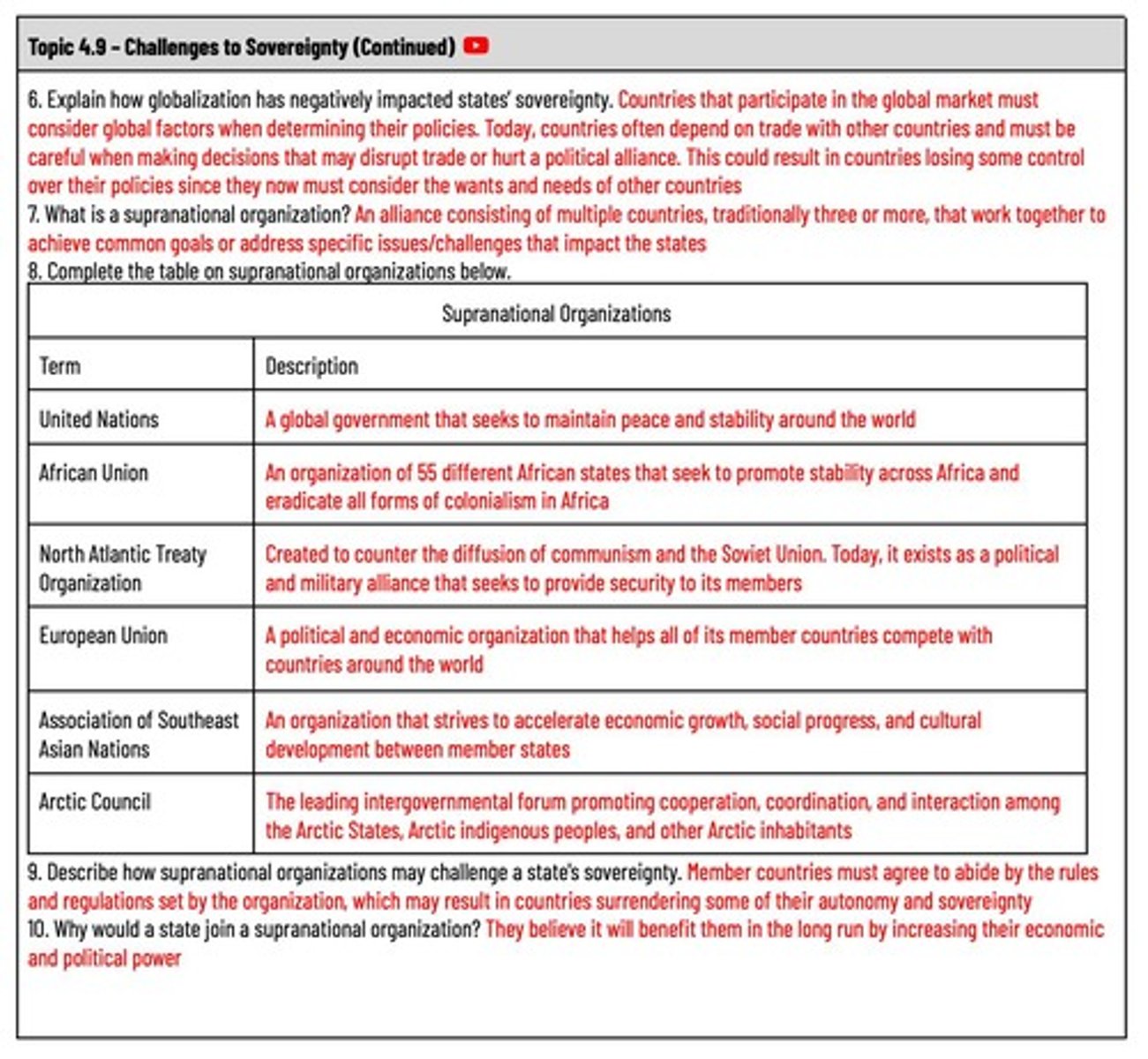Unit 4: Boundaries
1/123
There's no tags or description
Looks like no tags are added yet.
Name | Mastery | Learn | Test | Matching | Spaced |
|---|
No study sessions yet.
124 Terms
State
A geographic area with a permanent population, defined borders, and a sovereign government, recognized by other states.

Sovereignty
A state's authority to govern its own affairs, including domestic and international.
Nation
A group of people with a shared culture, language, history, homeland, and self-determination.
Nation-state
A sovereign state with a relatively homogenous population that has a shared language, culture, and history (one nation).
Self-determination
The right or desire for a nation or group of people to govern themselves.
Multinational state
A state that has multiple nations residing within its borders.
Multistate nation
A nation that is spread across multiple sovereign states.
Stateless nation
A nation with a history of self-determination that does not have a recognized state.
Autonomous regions
Regions that have a high degree of independence from the national government and can govern themselves.
Semi-autonomous regions
Regions that have a moderate degree of self-governance, with some say over their own economic and political systems.
Colonialism
The practice of acquiring territories and settling there to exert political, economic, and social control over the area.
Imperialism
The idea of growing a state or empire by exerting force over other nations to gain economic and political power without establishing settlements.
Berlin Conference
A meeting where European powers created states in Africa based on longitude and latitude, not ethnic groups.
Decolonization
A process by which a colony becomes independent of the colonizing country.
Devolution
The transfer of power from a central government to local or regional governments.

Political boundaries in Africa
Boundaries set up to facilitate the extraction of resources from Africa, often not reflecting local populations.

Problems from the Berlin Conference
1) Political boundaries did not align with cultural groups 2) Infrastructure was set up to extract resources, not operate a successful state 3) Increased conflict within states between different cultural groups.
Impact of colonialism on languages
Colonialism spread languages, such as English and Spanish, around the world.
Impact of colonialism on trade
New ideas and goods/services were traded due to colonialism.
Impact of colonialism on agriculture
New agricultural products allowed for population booms as a result of colonialism.
Effects of colonialism on citizens
Citizens of countries were suppressed and, in some cases, killed or sold into slavery.
Native American Indian reservations
They are autonomous regions because they are located within the United States of America but have a high degree of autonomy.
Territoriality
How people use space to communicate ownership of territory that connects to their culture, economic system, or political interests.
Neocolonialism
The use of political, cultural, or economic power to influence or control other countries.
Multinational Corporations and Neocolonialism
Multinational corporations often seek to exploit low-cost labor markets in economically developing regions, which helps reduce the cost of production.
China's Neocolonialism in Africa
China has been spending large amounts of money on African infrastructure projects to influence African countries politically and to use their cheap labor.
Shatterbelt
An area where countries or people are subjected to political, cultural, and economic pressure from external powers that are in conflict with each other.
Problems in a Shatterbelt Region
1) Political and economic influence from outside countries 2) May get pulled into a war that does not concern them 3) Could see fighting within their country 4) Citizens have to live in uncertainty 5) States will see lower economic growth and possibly less autonomy.
Demilitarized Zone
An area between two states that cannot be occupied or used for military purposes.
Choke Points
Geographic areas that have to be passed to reach a certain destination, which gain political and economic power over countries that do not own the choke point.
Examples of Choke Points
1) Panama Canal 2) Suez Canal 3) Strait of Hormuz 4) Strait of Malacca.
Boundary
A boundary is agreed upon, fixed, and set.
Defining a Boundary
The process of drawing a boundary on a map and physically marking it.
Delimiting a Boundary
The process of marking a boundary (e.g., with a border wall or sign).
Geometric Boundary
A boundary that follows the lines of latitude and longitude.
Example of a Geometric Boundary
The border between the United States and Canada.
Antecedent Boundaries
Boundaries that existed before human settlement and the creation of the cultural landscape.
Example of an Antecedent Boundary
The boundary between Chile and Argentina, which is formed by a mountain range.
Relic Boundary
A boundary that is no longer active but still impacts the cultural landscape (e.g., the Berlin Wall).
Superimposed Boundary
A boundary that was created by a foreign state or group, often seen in many African states created by European powers.
Subsequent Boundaries
A boundary that develops along with the development of the cultural landscape.
Consequent Boundaries
Boundaries that are drawn to accommodate existing cultural differences.
Consequent boundary
A type of subsequent boundary established to settle conflict between opposing cultural, ethnic, or political groups.
Subsequent boundary example
1) Majority of European countries 2) Boundary between India and Pakistan.
Frontier
A geographic area over which no state has direct power or control.
Superimposed boundary
Map A shows a superimposed boundary because we can see that the states in Africa were created by European powers.
Relic boundary
Image B shows a relic boundary. The Berlin Wall is no longer up today, but it still impacts the cultural landscape.
Consequent boundary example
Map C is an example of a consequent boundary. The former Yugoslavia split and created further borders due to conflict between the different ethnic groups.
International boundaries
Boundaries that separate one sovereign state from another.
Internal boundaries
Boundaries that separate different regions within a single state.
Definitional boundary dispute
A boundary dispute over the interpretation of the original documents that defined the boundary.
Locational boundary dispute
A boundary dispute over the location of the boundary and ownership of the land. For example, due to the Mississippi River shifting, there is a dispute between the states of Louisiana and Mississippi over the boundary.
Operational boundary dispute
A dispute over how to manage the boundary and handle different issues/situations that occur on the boundary.
Example of operational boundary dispute
The line of control between India and Pakistan. India wants to close the boundary due to terrorism concerns. Pakistan wants to leave the boundary open to allow people to migrate in and out of Kashmir.
Allocational boundary dispute
A dispute over the use of what is on or in the boundary (e.g., natural resources).
Goal of UNCLOS
The United Nations Convention on the Law of the Sea occurred in 1985 with the goal of helping countries better understand how to deal with boundaries in the sea.

Law of the Sea - Baseline
This is the shoreline.
Law of the Sea - Territorial Zone
12 nautical miles from baseline.
Law of the Sea - Contiguous Zone
24 nautical miles.
Law of the Sea - Exclusive Economic Zone
200 nautical miles.
States' Rights under Law of the Sea
States have sovereignty over their internal and external affairs.
Law of the Sea - Passage of ships
States can set laws regulating passage of ships from other countries.
Law of the Sea - Enforcement of laws
States may enforce laws concerning pollution, taxation, customs, and immigration.
Law of the Sea - Natural resources
States have the sole right to all natural resources (e.g., oil, natural gas, or fish).
International Waters
No state has control.
Law of the Sea and boundary disputes
It sets out clear rules to help states better understand their rights off of their countries' shoreline.
Conflict in the South China Sea
More than seven countries have a claim to part of this sea. However, China disagrees and has asserted it has a historical claim to the sea.
Examples of internal boundaries
1) Congressional district 2) County boundaries 3) City boundaries 4) School districts 5) Voting districts.
Voting district
A geographic area organized for the purpose of administering elections (such as election districts, precincts, or wards).
Redistricting
Occurs after a census has been conducted because populations change over time as people are born, die, and migrate.
Gerrymandering
A practice intended to establish a political advantage for a particular party or group by manipulating district boundaries.
Gerrymandering
The process of redistricting a voting district to favor one political party over another.
Cracking
The process of spreading like-minded voters out across multiple districts.
Packing
The process of stacking like-minded voters into just a few districts to reduce the impact of their vote in other districts.
Impact of Gerrymandering
1) Representatives do not reflect the beliefs of the people 2) Decreases the competition in political races 3) Weakens the democratic process 4) Creates safe districts.
Unitary Governance
Power is located in the central or national government. Little to no power is given to regional and local governments.
Federal Governance
Power is shared between the central or national government and regional governments. Decisions are made at both the local and national levels.
Positives of Federal Governance
1) Create a strong sense of nationalism 2) Can quickly respond to local issues 3) Can represent local communities and minority groups more effectively 4) Can quickly create new laws.
Negatives of Federal Governance
1) Cannot react quickly to local issues 2) May not represent all communities 3) Can be inefficient 4) Has a greater chance of experiencing devolution.
Devolution
The transfer of power from a national government to regional governments (power is broken up and distributed among lower organizations).
Factors Causing Devolution
1) Physical geography of a state 2) Divisions between different cultural groups 3) Political instability 4) Economic and social divisions 5) Governments abusing their power 6) Irredentism.
Ethnic Separatism
When a person or group starts to identify more as their own ethnic group than as a citizen of the state.
Basque People and Spain
The Basques are isolated from the rest of Spain by mountains. The Basque people have their own language and cultural identity that is unique to them, seeking more autonomy from Spain.
Catalonia
Catalonia is an autonomous region in Spain populated by the Catalan people who have sought independence from Spain, resulting in devolutionary pressures on the Spanish government.
Kurdish People
The Kurdish nation has its own language, culture, and a history of self-determination, but they do not have their own state.
Stateless Nation
A nation that has a history of self-determination but does not have a recognized state.
Examples of Stateless Nations
1) The Basques 2) The Catalans 3) The Kurds.
Nigeria and Devolution
Nigeria has experienced ethnic and religious conflict between different cultural groups, leading to devolutionary pressures due to the unequal distribution of resources.
Devolutionary pressures
Forces that push for the transfer of authority from central to regional governments, often due to identity clashes or demands for more local control.
Ethnic cleansing
When a government, organization, or group of people attack an ethnic group in a state with the goal of pushing the group out, often through mass incarceration or killing.
Irredentism
A movement by a nation to unite other parts of its nation that are located in another state.
State disintegration
The process where a state breaks up into smaller parts, ceasing to exist in its current form and resulting in the creation of new states.
Examples of state disintegration
1) Sudan (into Sudan and South Sudan) 2) Soviet Union (into 15 different states)
Negative impacts of social media on sovereignty
1) Can lead to devolution as information is more easily shared 2) Can cause a state to disintegrate 3) Access to more information reduces a state's control over citizens.
Democratization
A process through which a political regime becomes more democratic.
Globalization's impact on sovereignty
Countries participating in the global market must consider global factors in their policies, potentially losing control over their decisions due to trade dependencies.
Supranational organization
An alliance consisting of multiple countries, traditionally three or more, that work together to achieve common goals or address specific issues/challenges.

Terrorism and political instability's effect on devolution
When citizens feel unsafe, they are more likely to demand government intervention and may desire greater control over their own protection.
Economic and social inequality's role in devolution
When citizens perceive insufficient job opportunities or large inequalities, they may demand change, leading to protests or requests for more regional control.
Current conflict in Myanmar
The government has been accused of ethnic cleansing of the minority Rohingya people, denying them rights and citizenship, escalating in 2017 with a brutal campaign.